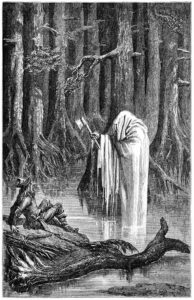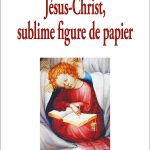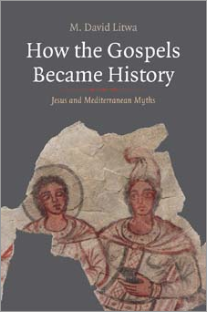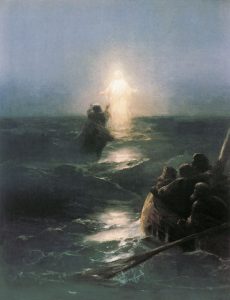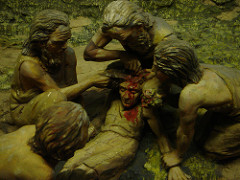Critique of the Gospel History of the Synoptics
by Bruno Bauer
Volume 2
—o0o—
61
§ 33
The Two Demoniacs of Gadara.
Matt. 8, 28-34.
According to Matthew, two demoniacs encountered Jesus when he landed on the other side of the sea, but Mark and Luke only mention one; so where did Matthew get the other one from? The way he came to him and how he generally comes to such companions is so strange, so incredibly adventurous that, as far as we know, it has no equal in either profane or sacred historiography.
Augustine insisted that there were two demoniacs who approached the Lord; Mark and Luke only spoke of one because he was more furious than the other, and Calvin agrees with this view of the holy bishop. *) The apologetic reformer must now claim that the reports are not contradictory, but it should be noted immediately that we must rely solely on Matthew’s account if we want to know whether only one of the two caused the Lord especially much trouble due to the violence of his rage. Only Matthew knows about two, so he should tell us that one was not as bad as the other; but he not only says nothing about it but explicitly presents both as equally raging and furious *) and thus spares us the trouble of examining the views of the great African more extensively. It also does Calvin no good to point out to us that Mark and Luke describe in detail the “rage of the devil” that had more control over one than the other – because can the number of words in the holy scripture decide and is it not enough that Matthew says that both were “very angry”?
*) Probabilis est Augustini conjectura, qui duos fuisse sentiens de uno tantum hic verba fieri excusat (!), quod magis famosus esset : atque ita propter mali atrocitatem magis illustre fuerit in eo miraculum. Et certe videmus Lucam et Marcum in saevitia diaboli amplificanda multis verbis insistere. Quod ergo unum insigne exemplum divinae Christi potentiae celebrant, a Matthaei narratione non dissidet, quae alterum hominem hic et minus cognitum adjungit.
*) C. 8, 28: χαλεποι λίαν.
62
Since modern criticism has taken the correct path and attempted to get to the bottom of the matter by examining the reports to see if one originated from the other, it was initially believed that the clear signs of its later origin could be found in the report of Mark. While Matthew only notes that the two demoniacs who encountered the Lord upon landing had come from the tombs and were very fierce, so that no one could pass that way, Mark describes in great detail the ferocity of his demoniac. He also says that the demoniac had come from the tombs, but adds a series of remarks, each of which is intended to explain the other: “the possessed man had his dwelling among the tombs and no one could bind him, not even with chains, for he had often been bound with shackles and chains, but he tore the chains apart and broke the shackles in pieces. And so he was day and night among the tombs and in the mountains, crying out and cutting himself with stones.” Finally (v. 15) when his fellow countrymen, seeing him healed and sane, also see that he is “clothed,” the evangelist implies retrospectively that the unfortunate man did not wear clothes before. Saunier *) says that this “breadth and detail” of the description, this “rhetorical and descriptive” attitude, proves that Mark is only reproducing in “broader expression” the simple account of another – Luke’s. Let us first stop at this more limited investigation (so that we do not yet consider Matthew), then we can still notice that Mark’s account not only is very broad, but also because of its verbosity it unnecessarily slows down the narration: how long do we have to wait before we hear what the possessed man did when he saw Jesus (v. 6)? Isn’t it more appropriate if Luke only briefly says (Luke 8:27) that a man who “had been possessed for a long time” met the Lord upon landing, didn’t wear any clothes, didn’t stay in any house, but stayed among the tombs, if he now immediately reports what he did when he saw Jesus (v. 28), and only then notes how (v. 29) the unfortunate man had been tormented by the unclean spirit? Isn’t it clear that Mark “has compressed and expanded the description given by Luke (v. 27, 29)”? **) Nothing less than that! Mark has only slowed down the narration, while Luke has interrupted it where it simply should not have been interrupted, and brought it into the wildest confusion, for once the whole thing is set in motion so that the possessed man actually calls on Jesus, what Jesus did must immediately follow – as it does with Mark. And as for the suspicious “compression and expansion” of the description, has Luke done nothing to that effect when he immediately notes at the beginning (v. 27) that the possessed man did not tolerate clothes and motivates it beforehand, that those people wondered when they later found the man clothed (v. 35)? Instead of being evidence against the originality of Mark’ account *), it actually supports it that the note about the nudity of the possessed man is not inserted into the description of his condition. Mark could be sure that everyone would have the perception of the previous state of the possessed man when he later describes the amazement of his compatriots – (Luke added this supplement) – but he still felt that he should not extend that description too much, so as not to interrupt the flow of the narrative even more than it already is. The evidence against Luke is finally completed when we read that the possessed man who met Jesus when he landed “came out of the city**),” as if he did not himself say that the unfortunate man lived outside in the tombs!
*) On the sources of the Gospel of Mark, p. 79-80.
**) de Wette, I, 2, 145.
*) As Fritzche also thinks, regarding Mark 5:15: You can understand that Mark has both used and abused the gospel of Luke (!).
**) εκ της πόλεως (23. 27.).
64
Now that it is certain that Luke copied the account of Mark and confused it with his attempts to improve it, the question arises as to how the simple account of Matthew compares to the more detailed account given by Mark. Strauss, although sympathetic to Matthew, wants to leave undecided whether Mark’s description is a “willful embellishment” of the “simple” statement of the wildness of the possessed ***). Okay! We don’t want to note yet how probable it is and is often confirmed that simplicity is the later completion, the rhetorical and, with all its breadth, still hard and awkward being the first attempt at historiography. We also don’t want to use the fact that Matthew speaks of two possessed persons, while Mark speaks of only one, to decide which account is original. On the contrary: before that, we want to point out the advantages that distinguish Matthew’s account from the others.
***) L. J. II. 33
65
All three accounts have in common that the possessed, as soon as they see Jesus, recognize him as the Son of God and know that he has come to destroy them. Indeed, Mark even says that when the possessed first saw Jesus from afar *), he ran over to him and shouted with a loud voice, “What have I to do with you, Jesus, Son of God Most High?” So Jesus has not yet had time to make his intentions known to the demon. Nevertheless, Mark immediately explains the demon’s address to us quite differently: not because he had recognized Jesus on his own, as is usually the case with his devilish companions, did he have the certainty that the Lord had come to destroy him, but because Jesus had commanded him to come out of the man (Mark 5:8, Luke 8:29). This is not only a contradiction in the account, but also in the matter itself, for now it seems that the Lord’s first command was ineffective, since after a longer negotiation with the demon, a second command had to follow in order to free the possessed from the devilish power. The contradiction arose purely out of thoughtlessness and the abundance of pragmatism. Matthew does not know it, for according to his account, the demons ask Jesus to send them into the herd of swine that was grazing nearby on the hillside by the lake.
*) Mark 5:6: μακροθεν..
Moreover, according to Luke’s account, after the demon recognized Jesus, he even begs him not to torment him *), but what right do the devil’s henchmen have to swear by God and to ask for mercy from the man they know has come to overthrow their rule? When will the devil soften, become sentimental, and even pious, so that he swears by the Son of the Most High before his heavenly Father? Matthew presented the matter quite differently, he does not let the demons beg, speak sentimentally, and swear, but only express the resentment they feel at the sight of their archenemy: “What have we to do with you, Jesus, Son of God? Have you come here to torment us before the appointed time?” **)
*) Mark 3:7: “What have you to do with me, Jesus, Son of God Most High? I adjure you by God, do not torment me.” So Luke (8:28: “…I beg you, do not torment me…”) has already taken offense at and softened Mark’s account.
**) Luke 8:29: “What have you to do with me, Jesus, Son of God? Have you come here to torment us before the appointed time?”
*) Μarκ 3, 7: τι έμοί και σοι, Ιησού, υιέ του θεού του υψίστου; ορκίζω σε τον θεόν, μή με βασανίσης. Luke (8, 28 : …. δέομαί σου, μη ….) has therefore already taken offense at the presentation of Marcus and mitigated it.
**) Luke 8, 29: τι ημίν και σοι, Ιησού υιέ του θεού; ήλθες ωδε προ καιρού βασανίσαι ημάς ;
66
Very well! And yet the account of Matthew is the later one, which, though it improves certain points excellently, must reveal that it did not create the original type, but rather changed it against its true nature at other essential points. The reason for these unfortunate changes lies in the plurality of the possessed. Strauss also does not want to decide here and only presents it as one of the possibilities ***), that “gradually the plural of the demons was replaced with the singular of the possessed.” Therefore, it must have happened, due to the increase of the contrast, that instead of two possessed, only one was assumed – but in the face of the multitude of demonic spirits that must be presupposed here, if a whole herd of swine is to be possessed by them, the difference of whether they previously dwelt in one or two possessed dwindles to almost nothing. The contrast remains equally great in any case.
***) L. J. II, 33. – De Wette states 1, 1, 88. 89. quite plainly that the account of Matthew is the original one, and that of Luke is the later expansion.
67
However, two possessed persons cannot come out. Although Matthew has them both express the request that if Jesus were to cast them out, he would send them into the herd of swine; he could not leave out this request if he wanted to motivate the following events, but it is and remains inappropriate, as the evangelist himself testifies when he suppresses the other requests and speeches attributed to the possessed person of Mark and Luke. How is it possible, or could it have been considered possible by the first author of the narrative, that two possessed persons could conceive the same thought in the same moment and speak it as if with one mouth? It is so impossible that even Matthew omits the dialogue between Jesus and the possessed person, the question of Jesus: “What is your name?” the possessed person’s answer: “Legion, for we are many,” and the request that Jesus not send them out of the country (Mark 5:9-10) or (Luke 8:30-31) into the abyss. However, the fact that there were so many of them had to be reported beforehand if the reader was to understand how the demonic spirits could take possession of a herd of swine; that they did not want to be sent out of the country or thrown into the abyss *), had to be mentioned if it was to be understandable how they came up with the idea of asking Jesus to let them enter the herd – so Matthew does not make it understandable how the demons could enter a whole herd of swine, and at least he does not motivate their request clearly enough when he lets them grumble in their first address: “Have you come here to torture us before the appointed time?” Before the time! namely, before we receive the final judgment, which is already predetermined for us by you? Another detail is missing in Matthew’s account. When the herd of swine was seized by the demonic spirits and rushed down the cliff where they were grazing, as if in a storm, and drowned *), the shepherds fled to the city and reported what had happened. The people then came out to Jesus and asked him, after they had convinced themselves of the facts, to leave their region. Jesus did what they wanted, boarded the ship, and at that moment the healed person asked him to take him with him. Jesus did not agree, but rather gave him the task of going home and proclaiming to his own what God had done for him. The man went and proclaimed in the Decapolis (Mark 5:20, according to Luke 8:39, throughout the city) what good deed Jesus had done for him. However, Matthew immediately has Jesus board the ship after the request of those people, and he reports nothing about a request from the two possessed persons, nor does he mention them again after he had once freed them from the evil spirits. Why? Schleiermacher tells us that the account comes from someone “who did not come into the vicinity of Jesus, but was instructed to stay by the ship” *). As if the man, having learned so much about the healing from others, could not have learned the rest as well! As if he did not have to have heard the request of the demoniacs, that Jesus take them with him, very clearly, as it was uttered in the moment when Jesus boarded the ship **)! Matthew omitted the necessary conclusion of the whole story, the conclusion he read in the writings of his predecessors but could not adopt. Not to mention that we must still hear how the demoniac was after the unclean spirits were cast out—(Mark and Luke tell us, by reporting that his countrymen saw him sitting at the feet of the Lord, Luke says)—so for the sake of contrast, the healed man had to appear again, set in motion, and conclude the whole action that we see in the account. His countrymen did not want to tolerate his benefactor in their area, and Jesus was actually expelled—should this dissonance, which deafens us in the whirl of its contradictions and robs us of our senses, now conclude the whole story? The refusal of those people to receive Jesus into their midst was formed only so that we would not know at the end why Jesus immediately returned after landing, and over there in the land where thousands of unclean spirits are to be found, where people dwell who are terrified of the Lord, should no witness of faith be left behind? No! Both aspects belong together and are formed for the sake of each other, each only for the sake of the other. Those people expel Jesus out of horror at the banner of the devil and because they themselves belong to the unclean, so that the healed man, with the confession of his faith, may stand forth more gloriously as a witness of the heavenly world and grace in that dark land. But Matthew could not give this resolution of the dissonance because he allows two demoniacs to be healed and because it was too unlikely that two people should have the same wish at the same time and express it to Jesus.
*) Mark assumed the idea, which is still present in modern belief in ghosts and evil spirits, that beings of this kind are sometimes bound to specific regions as local spirits, while Luke did not immediately share this belief and now thought of hell as the home of evil spirits, and Matthew finally thought of the final judgment which the Messiah will hold over the power of evil.
*) Only Mark (Ch. 5, 13) says that there were about two thousand of them, while the other two are content to write him down before (V. 11.) that the herd was large. Such specialties must be the basis for those who make Mark a compiler in the sense of the Griesbach hypothesis. For example, Fritzsche in the commentary on the Gospel of Mark, prologue, p. XLII Weisse (l, 65) has already responded to this, if Mark knew nothing better and no other “corrections” to add to the writings of his predecessors, he could have spared himself the trouble of researching and writing down, and Wilke has successfully shown that all these magnificent notes concerning the salvation of the world do not even come from Mark, but rather are later interpolations. Wilke has shown of most of them that they are highly suspicious, such as the statement of how many pigs were in the herd. We have often noticed how later historiography, since it has more abstract perspectives, blurs such meaningless details; this could also have happened this time, but it is very unlikely, since in this case – to present the miracle in all its greatness – it must have been of interest to Mark’s followers to indicate the exact number of unclean animals. However, the note also interrupts the context, since it separates too much the information that the herd rushed into the sea and that they drowned, just where the narrative, like its subject, should move quickly, and delays the movement of the whole. In any case, the entire passage is not constant in the manuscripts, and in a very respected one, that note is even missing.
*) a. a. O. p. 130.
**) Mark 5, 18: και εμβαίνοντος αυτού εις το πλοίον, παρεκάλει αυτόν ο δαιμονισθείς, ίνα ή μετ’ αυτού.
70
The duality of the possessed is thus a contradiction to the original tendency and structure of the report, and a later, sole addition by Matthew. It is also no longer a secret where the evangelist got it from. Previously, he had read in the Gospel of Mark (Chapter 1, 21-27) that when Jesus first came to Capernaum, he taught in the synagogue and healed a possessed man. However, since he had already used the note on Jesus’ teaching and its powerful impact on the people for the Sermon on the Mount and had to omit the scene that took place in the synagogue, he could not report anything about the possessed man. But he did not want to completely let go of this tidbit. What does he do now? At the first suitable opportunity, he takes it up and – casually, but oddly enough! – makes two possessed out of the one that Jesus heals on the other side, on the opposite shore *). He even has the Gospel of Mark before him at this moment, for he borrows from it the exclamation with which the possessed man in the Capernaum synagogue acknowledges that he knows well that Jesus is the Holy One of God and has come to destroy him and his associates **). This enabled him to so successfully give his possessed man the appropriate snarling address, while Mark did not dare repeat these words and also had already the request of the unclean spirit for relief from its fate in his head, which was the foundation of the whole story, and was woven into the first words of the unclean spirit too early.
*) Weisse, 1, 497 regards this explanation as “more probable” than any other; Wilke (p. 683), based on his insight into the relationship between the synoptic accounts, could describe it as the only correct one.
**) Mark 1:24: τι ημϊν και σοι Ιησού ; ήλθες απολέσαι ημάς οίδα σε τις ει, ο άγιος του θεού.
71
We haven’t seen the apologist for a long time; we have indeed seen him, he has also thrown us the crumbs of his wisdom while we were dealing with the possessed, but we have not seen him in his true element, in the holy zeal that suits him so well. But now we only need to say that the conclusion of the account, the request of the healed man and the request of his fellow countrymen, is pure, so is the whole account a work of ideal contemplation, since its individual features cannot deny their literary origin, and since there are no unclean spirits that could intrude alongside or even take the place of human self-consciousness, the apologist stands in full glory. For the scripture indeed says that those unfortunate people were possessed by evil spirits, the companions of Beelzebub, that is, by spirits from the kingdom of Satan, and not only do the sufferers testify to the reason for their sufferings, for it is not they who speak, but their tongues have become the organ of those spirits: Jesus himself also bears witness, since he always addresses the unclean spirits and commands them to depart. And as it is written, the apologist answers, so it is true, so it is correct, and it remains so. For if it were otherwise, that is, if those sick people were not really possessed by devilish spirits, would Jesus, “who saw so far beyond his contemporaries in more delicate and dangerous matters and whose deeper insight into the human soul cannot be denied, have really embraced such a clumsy mistake?” *) Clumsy? How he gets worked up so quickly! Clumsy! But Jesus was not a physiologist and speculative psychologist, and a mistake cannot be called clumsy that was connected with the religious worldview of the people. We will not even call that religious view clumsy, even if the new investigations, for which Strauss has provided the most important contributions, have taught us that the so-called state of being possessed is nothing more than the illness of the self-consciousness that has gone out of itself, which sees its inner differences as external, foreign, and forcibly imposed powers.
*) Hoffmann, L. J. p. 355.
72
But, Hoffmann continues, “all these psychologically ill people assure that something foreign seems to have entered their being (!), which they cannot account as part of themselves” *). They are simply sick and have lost the rational contemplation that was not even given to them as scientific insight. “This foreign thing arouses ideas in the sufferer, therefore it must be a spirit.” As if the sick person were not a spirit and their suffering, if it consists in the delirium of self-consciousness, must manifest itself in the form of representation. “This foreign thing acts irresistibly.” Because the sick person has lost their freedom. “It disturbs the sick person when they want to think and pray religiously.” If this disturbance actually occurs, it is because the pathological condition consists in the liberation and external celebration of the internal contradictions of the spirit and the general power that holds together and dissolves these contradictions in a healthy and rational state has been taken away from the mentally suffering individual.
Finally, the apologist becomes mystical – no, not really! He flees to mystical phrases **): “why should it not be possible for the human soul to temporarily sink into the dark, elementary ground of its existence?” But is the realm of Satan and his companions the foundation of the soul? Of course, the apologist means it differently; he wants to leave it undecided whether this foundation is already “personified” or whether it only takes on a specific form in the sick individual. But it is certain that in the sick person, this foundation becomes “a conscious person”, namely a person different from the sick person – even a legion of people? – and only then can one leave undecided whether it is still a person afterwards, abandoned by human individuality.” But this brew of fear – the religious explanation of possession must be maintained – of unbelief – which does not allow that according to scripture, the unclean spirits are companions of the devil – of natural philosophical clichés – and the “dark ground of existence” is not even a philosophical category, but a mythological image – this brew of the most intolerable ingredients is supposed to stupefy our concept and make the credibility of a report that can no longer be maintained plausible to us?
*) Ibid. p. 556.
**) Ibid. p. 358.
73
The report can no longer be considered credible in the theological sense. The point that forms its center, namely that the demons caused their own downfall by asking the Lord to let them enter the swine so that they could at least stay in the local area, will only be considered historical as long as the belief in possession really sees the suppression of self-consciousness by demonic spirits. However, once the true nature of that illness is recognized, it becomes impossible to regard even an atom of this report as historical. Yet, Weisse considers it possible that even for the more recent scientific consciousness, that point of the report could still be saved, since those who know about the powers and states of animal magnetism have considered the possibility of a transition of demonic states “from others and even onto animals.” However, Strauss has rightly noted that “the participation of horses and other (we can even say: more removed from bestiality) animals in the so-called second sight of the Scottish and Danish island inhabitants is the only thing securely attested *) to as the communication of organic-psychic states to animals.” The pig, however, is still much too much of a beast and closed to participating in human states, which horses and dogs, for example, are capable of, so it cannot be open to the communication of organic-psychic states.
*) L. J. II. 4l.
74
The point that the demons seek and do not find a new home in the pigs also agrees with the modern view that the devil, if he wants to be clever and make a pact in his favor, is foolish and harms himself. “But,” asks Weisse **), “how can one explain the fact that the inhabitants of the region where the miracle was performed, instead of admiring and praising Jesus for it, were rather seized with terror and fear, and wanted to send him away as soon as possible (according to Tert: immediately), especially if one thinks that the story was invented to glorify Jesus?” Nothing could be easier if one does not expect, as earlier criticism did, that the glorification should emerge abstractly: does not the sublime also glorify itself in the horror that it inspires in the lowly, in the horror and in the agitation that its revelation evokes in the dull and closed minds? “Also, the admonition with which Jesus rejects the healed man who wants to follow him is anything but in the tone in which one could recognize a type for such incidents.” But if a type is to be understood as the inner necessity that forms the features of a particular view and holds them together through the tension it creates, then that admonition is also necessarily included in the internal purpose of this report: in the land of the dull and closed, Jesus must leave a witness of his power.
**) I, 198
It was only a contrast – and a very comprehensive and far-reaching one at that – that created the view that unclean spirits in the possessed recognized Jesus from the beginning as the Son of God and called upon Him as such. When Jesus appeared for the first time in the synagogue in Capernaum, the demonic who was present there or rather the demon in the unfortunate person called out to Him: “I know who you are, the Holy One of God” (Mark 1:24). This was generally the case: the devilish spirits knew Him (1:34) and cried out when they saw Him: “You are the Son of God!” But He threatened them not to reveal Him (3:11-12). However, how could it be possible that the insane were betrayed the secret from the very first moment, which would only be revealed and explained to the disciples and the community through a long history, through a series of difficult mediations and in faith in the risen one? Yes, if it was really the spirits of hell, the servants of Satan, who possessed the people at that time, then it was indeed natural that they recognized the Son of God, who had come to destroy their power; they had to know their archenemy, because Satan knew Him, and his companions had to know Him as well, as they belong to a spirit world which is not bound to finite mediations of experience. But since the demonic are nothing but mentally ill, they lose their omniscience, which was in fact only a gift of the ideal view of the later community, and it would not even help their lost cause if one were to rely on the premonition ability of somnambulists. Because it never aims at the generality and the innermost of the self-awareness of another person, let alone a person with whom the somnambulist had so far had no relation, but only worthless particularities and mental determinations that are connected with the physical organism – determinations that have nothing to do with the self-awareness of the Redeemer and God-man – are accessible to it.
76
So the question is no longer how the demonic beings could recognize Jesus as the Son of God – because that was impossible – but why it had to be so and why the evangelical perspective demanded the impossible from them. The Gospel of Mark gives us the answer. Only once does Luke follow his predecessor’s remark that the demons called Jesus the Messiah, the Son of God (Luke 4:41), namely in the context where Jesus heals the sick in front of Peter’s house, and where this note could not be missing if the report was not to be too sparse and the author had nothing else to put in its place. Afterwards, when Luke comes to the second place where Mark gives that note (Luke 6:17–19), he leaves it out completely, believing he has given enough material already, besides presenting more extensively than Mark that everyone sought to touch Jesus, “because power was coming from him and healing them all,” and finally because he hastens to the Sermon on the Mount. Luke no longer recognizes the value of that note. Matthew, however, no longer needs it at all; he even leaves it out in the first place where Jesus drives out the demons in front of Peter’s house and instead puts in its place (Matt. 8:17) the remark that Jesus healed so that the prophecy of Isaiah, “He took our infirmities,” would be fulfilled. What Luke left out once unintentionally and because he no longer knew the original purpose, Matthew deliberately eradicated twice, if he was at all aware of his own distinctive pragmatism. According to his account, Jesus proclaims himself from the beginning as the judge of the world and the Messiah – so why should he command the demons to be silent when they call him the Son of God? According to his scripture, Jesus was recognized from the beginning (chap. 8, 6) as the miracle-working Messiah – so how could it still seem remarkable and significant that even the demons recognize him as the Holy One of God? The note of the sharp-sightedness of the hellish spirits had thus become not only worthless and superfluous but also disturbing, and it had to be eliminated. Mark, on the other hand, had constructed his presentation on the fact that Jesus was recognized as the Messiah by the disciples and the people only at the end of his work. But it was impossible for a Gospel writer, especially the one who wrote first and built the structure of his writing freely, to bear that no one really recognized the Lord as the Messiah and confessed him as such. He had to even establish confessors at the very moment when Jesus appeared, who would testify how powerful and compelling the impression of the Lord’s personality was, and since people could not understand this impression immediately, spirits had to explain it, who by their nature possess a sharper vision.
77
Therefore, only as a testimony that he had come to destroy the kingdom of darkness and as proof of the power that he still gives to his followers in their struggle with Satan, must Jesus fight with the demons.
———————–


